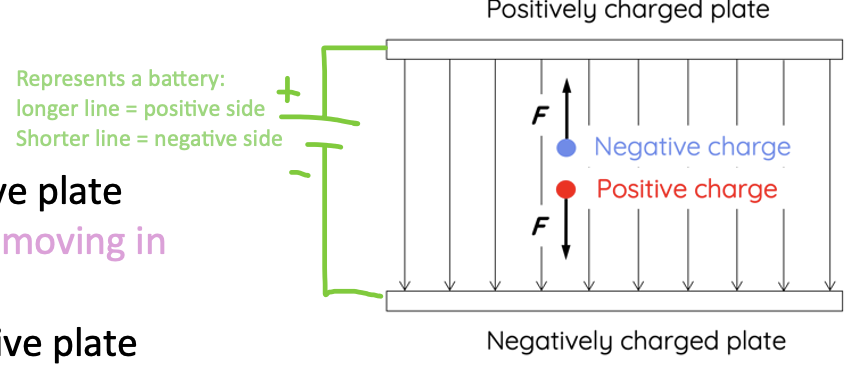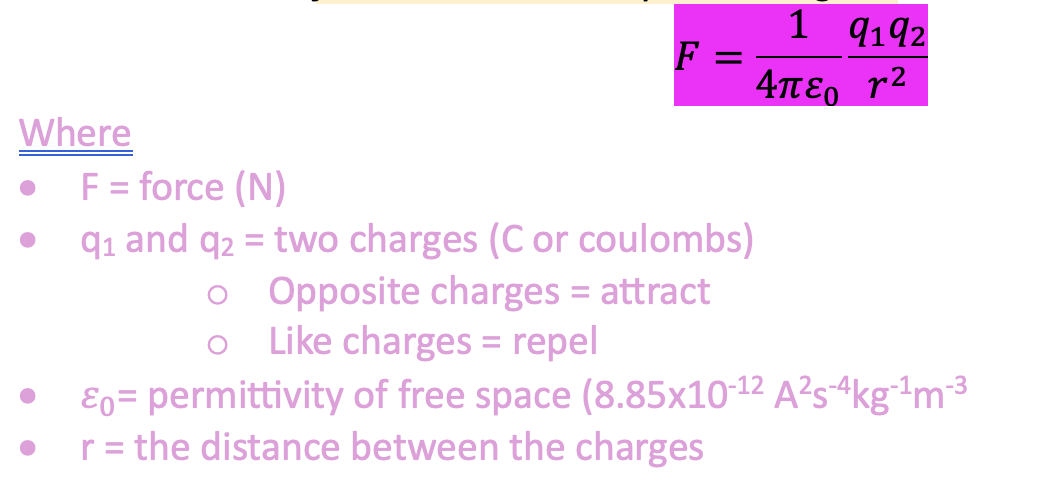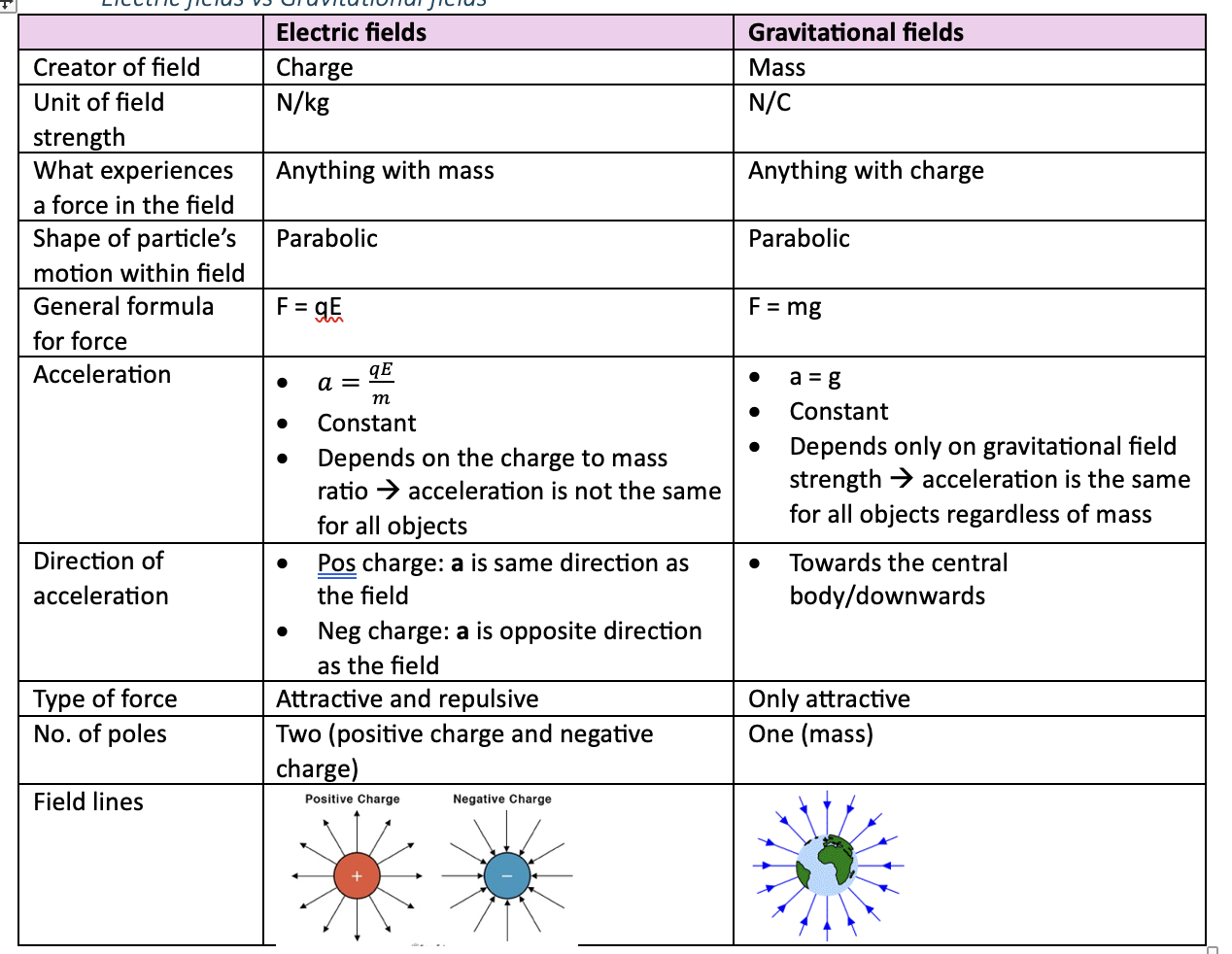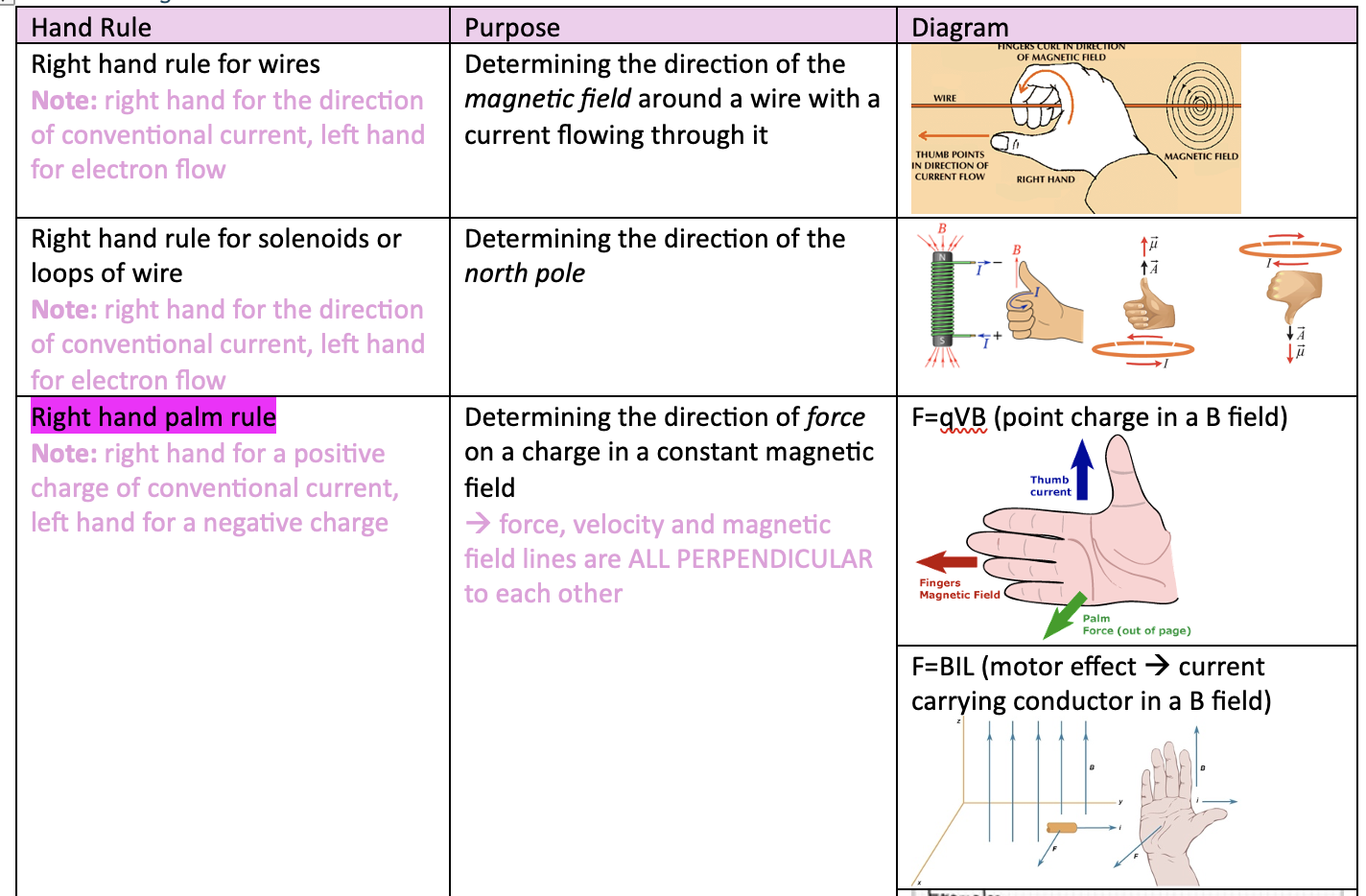Charged Particles, Conductors and Electric and Magnetic Fields
1/15
There's no tags or description
Looks like no tags are added yet.
Name | Mastery | Learn | Test | Matching | Spaced |
|---|
No study sessions yet.
16 Terms
How are electric fields defined and represented
defined by the direction of fore on a positive text charge
Electric field lines come out at 90° to the surface of the charge
Denser the lines = stronger the field
For a point charge, it is when it is closer to the charge
More lines = more charge (e.g. double the lines = double the charge)

Note: MASS does not contribute to electric field strength, only magnitude of CHARGE
Uniform electric field
created by parallel plates
Same electric field strength at any point
Direction of E field is in the same direction
Negative charge = moves against field towards positive plate
negative sign (if you put charge as negative) = it is moving in opposite direction to field lines
Positive charge = moves with the field towards negative plate

Equation for electric field strength + force in constant e field
q = number of electrons x charge of electrons (-1.602×10^-19)
F=qE → lorenz force
E=V/d = F/q
Note: Force between charged objects
Charged object → makes electric field → electric force → work → change in energy (K or U)
Coulombs law
force between two-point charges

Potential difference and work
Potential difference (voltage)
work done per unit charge moving between two points
V=W/q
Work (change in K or U energy)
W=∆K=qEd=qV
Motion of charges in electric fields
Milikan oil drop
1D
2D
Millikan’s Oil drop experiment | When a charge is suspended motionless between two plates ∴ Fnet = 0 ∴ Electric force = gravitational force ∴ qE = ma can put values in and rearrange for unknowns To find the charge of the particle:
|
1D | When a charge attracted to the plate of the opposite charge (only x or y direction)
(What was studied above) |
2d | When a charge is moving in the x and y direction
|
Radial field | coulomb’s law  |
Electric fields vs Gravitational fields

Magnetic fields definition + representation
defined by how a north pole would react
made by magnets / moving charges
Leave perpendicular to the surface
Always forms closed loops
To indicate the direction
Dots and crosses convention (think of shooting arrow)
X (cross) = direction of vector is into the page = tail of arrow
(dot) = direction of vector out of the page = head of arrow
Lines with arrows
Arrow points to the left/right/up/down = direction vector is that way
When two magnetic fields overlap, use vector addition to find the resultant field
Right Hand Rules

Formula for B for
current carrying conductor wires
solenoids
wire:

solenoid
ncrease B by:
· Increasing the number of turns per unit length (decrease length while increasing turns)
· Increasing current
· Putting a ferromagnetic material (e.g. soft iron core) in the middle to amplify the field

Magnetic Force on a Moving Charge
F=qvB sinθ
→ theta is angle between B and v
A charged particle moving in a magnetic field experiences a magnetic force
It will NOT experience a force if it is moving parallel to the field
Maximum force if moving completely perpendicular to the field sin𝜃 is 1
No charge = no force experienced
Path of a charged particle in a constant B field
(assume no gravity, unless stated otherwise)
A charged particle will always move in UCM in a magnetic field since it satisfies all the conditions to undergo UCM
NO WORK IS DONE IN UCM = NO WORK IS DONE IN MAGNETIC FIELD
→ KE is constant, speed is unchanged
1. Force is constant because the magnetic field is uniform (F=qvBsin𝜃)
2. Force is always perpendicular to velocity (due to right hand palm rule)
∴ Follows uniform circular motion for as long as it is in the field
Thus, the provider of UCM is the magnetic field

Cathode rays - what is it + how to generally solve qs involving them
Guns that shoot out electrons → generally when they are shot out, they go through a B or E field, which alters their path
Two electrodes act like parallel plates to create an electric field (+ to -)
Negative electrode = cathode = where electrons are shot out of
Positive electrode = anode = where electrons are received
Work is done between the two electrodes to increase the kinetic energy of the electron (thus the velocity)
Speed at anode if electrons are at rest at cathode:
W = qV = ½mv2 = rearrange for v
After the anode there can be a magnetic/magnetic field that acts on the charge = causes change in motion
Deflection by magnetic fields - UCM → use RHPR to figure out the direction of deflection
Deflection by electric fields - parabolic → use knowledge of attraction between charges to figure out direction of deflection
For the electrons to be undeflected:
Fnet = 0, FB = FE
qvB = qE
E = vB
Comparison of motion in uniform fields: G, B and E
| Gravitational Field | Electric Field | Magnetic Field |
Who creates the field | Mass | Charge | Moving charges (currents) or magnets |
What experiences the force in the field | Anything with mass | Anything with charge | Moving charges (currents) or magnets |
Likely shape of particle’s path in this uniform field | Parabolic | Parabolic | Circular |
Reason for shape of path | Force in one direction | Force in one direction | Force perpendicular to velocity, provides centripetal force |
General formula for force on particle | F = mg | F = qE | F = qv⟂B |
Units of field strength | N/kg | N/C | T |
Magnitude of acceleration | a=g → independent of mass | a=qE/m → depends on charge to mass ratio | a=(q/m) vB → depends on charge to mass ratio |
Direction of acceleration | In direction of field | In direction of field for pos charge Opposite for neg charge | According to right hand palm rule for positive charge. Opposite for negative charge. |
Is work done | Yes (for parabolic motion) No (if in circular orbit) | Yes (parabolic motion = K changes) | No (due to UCM) |
Comparison of uniform circular motion: G and B
| Orbital motion around a planet | UCM in a magnetic field |
Field | Gravitational field of the planet | Uniform magnetic field |
Shape of field | Towards centre of planet | Uniform, constant direction |
Shape of path | Circular (no work) | Circular (no work) |
Reason for shape of path | Gravitational force is towards the central body while velocity is tangential | · Magnetic force perpendicular to velocity · Force is constant |
Provider of Fc | Gravitational force | Magnetic force |
General formula for force on a particle | F=GMm/r² | F=qvBsin theta |
Condition for UCM | Fc=Fg v=√GM/r | Fc=Fb r=mv/qB |
Magnitude of acceleration | a=g | a=(q/m)vB |
Direction of acceleration | In direction of field | In direction of field for pos charge Opposite for neg charge |